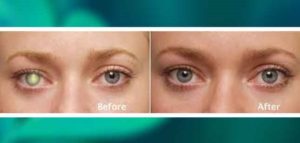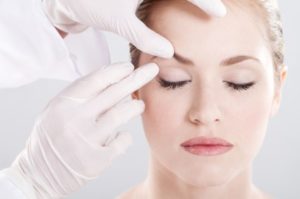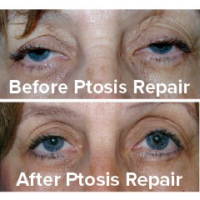Overview of Oculoplasty
Oculoplastic surgery is the cosmetic, corrective, and reconstructive surgery of the eye. It manages and repairs problems primarily related to the tissues or structures surrounding the eye, rather than the eyeball itself. These structures include the eyelids, the tear ducts, and the orbit (bony socket surrounding the eye). Ophthalmic plastic surgeons are board-certified ophthalmologists who have completed several years of additional, highly specialized training in plastic surgery.
Types of Oculoplastic Surgery
Oculoplastic surgery covers a wide range of procedures, including:
- Eyelid surgery, including blepharoplasty and eyelid reconstruction, for ptosis, entropion, ectropion, and eyelid tumours
- Tear duct surgery
- Orbital surgery to manage thyroid and eye disorders, tumours, and trauma
- Paediatric oculoplastic surgery to correct congenital defects and manage eye disorders in children
- Eyebrow and forehead lifts
- Facial rejuvenation (midface lift, lower face lift, facial implants)
Non-surgical treatments performed by oculoplastic surgeons include:
- Skin rejuvenation (laser skin treatments, chemical peels, home skin care regimens)
- Facial filler injections (Juvederm, Perlane, Restylane, Radiesse) to reduce wrinkles
Types of Oculoplasty
Eyelid Surgery: It can correct various problems like entropion, ptosis, eyelid tumours, and ectropion, etc. It is also useful in removing excessive fat or skin on the eyelids, commonly known as Eyelift surgery.
Installing grafts or flaps for eyelids: Various types of skin cancers and malignant melanomas are treated using flaps, grafts or other reconstructive surgeries. These procedures are performed by Oculoplastic surgeons. They also perform canthectomy where tissues from the joint of lower and upper eyelids are removed. They remove eyelid tumours also.
Lachrymal procedures: Issues related to the tear gland and tear duct are removed by surgeries. Opening blocked tear ducts, removal of lachrymal gland, restoring the function of tear duct, and clearing the drainage of tears are a few examples.
Eye removal: When there is a need of removing the eye and keeping the eye muscles and orbital contents intact, then also Oculoplastic surgeons use their skill. It is usually performed when there is an unbearable pain in a blind eye.
Exoneration: It means removal of entire orbital part and the eye along with extra ocular muscles, connecting tissues, and fat. It is performed in the case of malignant tumours.
Who can undergo the surgery?
Since it is aimed towards enhancing appearance and comfort, anybody who is physically fit can undergo the surgery. The defects may be there since birth, or they may appear at the later age. Accidents, diseases, and other factors cause problems that not only hamper the vision, but affect the appearance also. Problems like droopy eyelids may cause practical difficulties, and people can’t perform daily activities. Similarly, there is a need for removing a damaged eye because of aesthetic purpose.
Doctors check the physical history and decide whether the patient is fit for the surgery or not? If there are critical health issues like heart problem or diabetes, then a detailed investigation is carried out to minimize the risk. A team of specialists evaluates the risk associated.
Oculoplastic procedures:
Oculoplastic surgeons perform procedures such as the repair of droopy eyelids (ptosis surgery), repair of tear duct obstructions & watering eyes (lacrimal surgery), orbital fracture repairs, removal of tumours in and around the eyes, eyelid reconstruction (post eyelid skin cancers) and facial rejuvenation procedures including laser skin resurfacing, eye lifts (blepharoplasty), brow lifts, Botox for eyelid conditions like blepharospasm and facelifts.
Before Surgery
- Your surgeon may give you some instructions to follow before your surgery. You may need to:
- Stop any medicines that thin your blood. Your surgeon will give you a list of these medicines.
- See your regular health care provider to have some routine tests and make sure it is safe for you to have surgery.
- To aid with healing, stop smoking 2 to 3 weeks before and after surgery.
- Arrange to have someone drive you home after surgery.
How it goes?
Oculoplastic and lacrimal surgery is a sub-specialty of ophthalmology which focuses on disorders of the eyelids and tear-drainage system. It has evolved as a distinct sub-specialty of ophthalmology gradually during the last three decades in the UK. In the 1970s and 1980s, there were a number of ophthalmologists with an interest in oculoplastic and lacrimal surgery, but most common eyelid and lacrimal disorders and surgical procedures were considered to be within the remit of the general ophthalmologist.
Today, the scene is somewhat different. Eyelid and lacrimal disorders are very common and minor disorders form a significant part of the workload of primary care ophthalmology in the community and hospital setting. However, eyelid and lacrimal disorders that do not respond to simple non-surgical measures increasingly tend to be referred to an oculoplastic and lacrimal service. Oculoplastic and lacrimal surgery remains within the specialty training curriculum for ophthalmology and general ophthalmologists commonly undertake less complex oculoplastic procedures such as entropion and ectropion correction. Ophthalmologists who specialise in this field commonly undertake additional training in advanced techniques following specialty training in ophthalmology and much work exclusively in the sub-specialty. The heavy oculoplastic and lacrimal workload even in relatively small units often makes it impractical for them to maintain their skills in cataract surgery, for example.
The surgical repertoire of the oculoplastic and lacrimal surgeon includes correction of eyelid appositions (eg entropion, ectropion, ptosis, and lid retraction due to thyroid eye disease), treatment of in growing eyelashes, removal of tumours of the lids and surrounding tissues and reconstruction of these tissues following tumour excision or trauma. Removal of the eye, once a relatively common operation performed by general ophthalmologists is now much rarer and is usually undertaken by oculoplastic surgeons, with implantation of a prosthesis in the socket wherever possible, to aid the subsequent fitting of an artificial eye.
They may also undertake secondary reconstructive procedures on the socket following earlier removal of the eye. Excessive watering of the eye is an extremely common reason for referral to an oculoplastic and lacrimal surgeon. Often the treatment is non-surgical, or involves correction of an eyelid malposition, but a proportion of these patients have an obstruction or increased resistance in the lacrimal drainage system. Dacryocystorhinostomy (DCR) involves fashioning a connection between the lacrimal sac and the lateral wall of the nose, having made an opening through the thin lacrimal bone which normally separates them. This may be done through a skin incision over the lacrimal sac, or via the nose (endoscopic DCR). Endoscopic DCR requires the surgeon to be proficient with a nasal endoscope and it is sometimes necessary to correct abnormalities of the nasal septum or turbinate bones to gain access. The ophthalmologist must either acquire the necessary competencies in nasal surgery or obtain the help of an ENT surgeon.
Some oculoplastic and lacrimal surgeons undertake aesthetic or cosmetic surgery of the eyelids and periocular tissues. This field of surgery includes techniques to rejuvenate the appearance of the periocular tissues, procedures to alter the shape of the eyebrows and procedures to correct minor abnormalities of eyelid position that would not normally qualify for treatment under the NHS. Many of the techniques used in aesthetic surgery are similar to those used in other aspects of oculoplastic surgery.
Oculoplastic and lacrimal surgeons often have close working links with related specialties such as dermatology, oncology, ENT and plastic surgery and may be part of a multi-disciplinary team for the management of specific conditions. For example, dermatological surgeons who remove periocular basal cell carcinomas using Mohs’ micrographic surgery often work in partnership with an oculoplastic surgeon who will undertake the subsequent reconstruction.
Pathologic eyelid drooping, also called ptosis may occur due to trauma, age, or various medical disorders. This condition can affect one (unilateral ptosis) or both (bilateral ptosis) eyes, it may come and go, or it might be permanent. It can be present at birth (known as congenital ptosis) or you can develop it later in life (known as acquired ptosis).
Depending on the severity of the condition, drooping eyelids can block or greatly reduce vision depending on how much it obstructs the pupil. In most cases, the condition will resolve, either naturally or through medical intervention.
What to Expect
For most procedures, you will be able to go home the same day you have surgery. Your procedure may take place in a hospital, an outpatient facility, or the provider’s office.
Depending on your surgery, you may have local anaesthesia or general anaesthesia. Local anaesthesia numbs the area so you do not feel any pain. General anaesthesia puts you to sleep during surgery.
During the procedure, your surgeon may place special contact lenses on your eyes. These lenses help protect your eyes and shield them from the bright lights of the surgical room.
Risks
There can be various complications in Oculoplasty surgery, just like any other procedure. Sometimes, the wounds get burst, blemishing occurs, or lopsidedness can also occur. In very rare cases, there is an allergic reaction to anaesthesia. Similarly, loss of vision or visual injury can also result from the surgery. Some people face the problem of overcorrection. However, all these complications are very rare. The possibility of such issues happening can be further minimized by doing detailed investigation prior to surgery.
Post-operative care.
Patients shouldn’t indulge in heavy exercise, sports, aerobics, weightlifting, and other strenuous work for eight to ten weeks. Eye makeup should be avoided for at least two months. There are no restrictions on diet, but the patients should eat high fibre diet to avoid constipation. They are allowed to resume duties after two to four weeks depending on the speed of recovery and the nature of the profession. Regular checkups and follow-up meetings are scheduled as per condition of the patient.
Care at Home
Your recovery will depend on your condition and the type of surgery you have. Your provider will give you specific instructions to follow. Here are some tips to keep in mind:
You may have some pain, bruising, or swelling after surgery. Place cold packs over the area to reduce swelling and bruising. To protect your eyes and skin, wrap the cold pack in a towel before applying it.
You may need to avoid activities that raise your blood pressure for about 3 weeks. This includes things such as exercise and lifting heavy objects. Your provider will tell you when it is safe to begin these activities again.
DO NOT drink alcohol for at least 1 week after surgery. You may also need to stop certain medicines.
You will need to be careful when bathing for at least a week after surgery. Your provider can give you instructions for bathing and cleaning the area around the incision.
Prop your head up with a few pillows to sleep for about 1 week after surgery. This will help prevent swelling.
You should see your provider for a follow-up visit within 7 days after your surgery. If you had stitches, you may have them removed at this visit.
Most people are able to return to work and social activities about 2 weeks after surgery. The amount of time can vary, depending on the type of surgery you had. Your provider will give you specific instructions.
You may notice increased tears, feeling more sensitive to light and wind, and blurring or double vision for the first few weeks.
